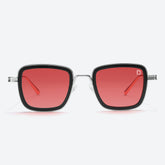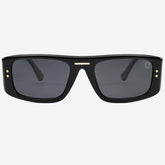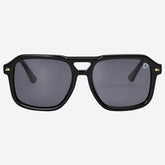Disadvantages Of Polarized Sunglasses And Other FAQs
Polarized sunglasses are popular for reducing glare and enhancing visual comfort, but they come with some drawbacks. In this article, we’ll explore the disadvantages of polarized sunglasses and answer common questions. While these lenses offer many benefits, they can also affect depth perception, distort screens, and alter colors. Understanding these limitations can help you decide if polarized sunglasses are the right choice. Read on to learn more about when to avoid polarized lenses and get answers to other frequently asked questions about these popular sunglasses.
What are the downsides of polarized sunglasses?

There’s so much discussion about the benefits of polarized sunglasses, and rightly so. These sunglasses protect our eyes from glare (harsh reflections from light sources), especially from the sun. They also offer better vision, especially outdoors. However, this does not mean there aren’t downsides to owning and wearing sunshades. Here are six disadvantages of polarized sunglasses.
More Expensive
As much as we all love to step out with bucket loads of steeze, fashion still depends on the size of your pocket. This is not to say that you can’t be fashionable on a budget, but certain fashion items will cost you more if you must have them, and polarized sunglasses are one of them. On average, polarized sunglasses cost about 25% more than unpolarized sunglasses. Of course, the benefits make the price worthwhile, but polarized sunglasses may not be your best option if you're on a budget. Instead, you can opt for regular sunglasses with UV protection. They’ll still offer improved vision in the sun and protect your eyes from the sun’s harmful UV rays.
Darkens LCD screens
Polarized lenses don’t work well with LCD screens, which can be problematic because our world is getting even more digital daily. In a world where we’re surrounded by screens, if you try viewing a digital screen made of LCD, you may be unable to see what is displayed. This is because LCDs come with an in-built polarizer as part of their design. These already filter off light such that only light traveling in a particular direction passes through.
Now, when light from such screens passes through polarized lenses—so-called because they contain a layer of polarizer—the displayed image appears distorted or dim. So, activities like checking your location on your car’s GPS screen become an issue, and you may miss essential information.
This doesn’t make polarized sunglasses terrible for driving. On the contrary, they’re fantastic—especially on sunny days—because they reduce glare, making your eyes less likely to be fatigued from prolonged focus in harsh lighting conditions. However, you may need to remove your glasses momentarily to read your GPS screen.
Reduced Visibility In Low-Light Conditions
Another on this list of the disadvantages of polarized sunglasses is reduced visibility in low-light conditions. Since polarized lenses are designed to reduce glare from bright light, they make your vision dimmer, which isn’t a problem in bright conditions. However, they may not be as effective in low-light conditions. This can be a disadvantage when transitioning from bright to dim environments, like sunsets, sunrises, or dimly lit apartments. While wearing polarized sunglasses, activities like running, walking, or driving in such conditions may be dangerous.
Depth Perception Issues
Polarized sunglasses can sometimes affect depth perception, which is important for activities like driving, snowboarding, skiing, or motorbiking. These lenses reduce glare, making it harder to see shiny patches of water or ice. This can be dangerous since spotting these hazards early is crucial for safety. Non-polarized lenses might be better in these situations because they allow you to see these hazards more clearly. If safety is a priority, especially in activities involving speed and changing terrain, non-polarized lenses could be the safer choice.
Also, this change in how we see distances and depth can make some people feel disoriented, dizzy, or even nauseous. However, It’s important to know that feeling nauseous from polarized lenses is rare.
Limited Lens Tint Options
Polarized sunglasses often come in limited lens tint options, usually gray, brown, or green. This is because the material, like CR39, used to make the polarizing filter restricts the range of colors available. If you prefer a specific non-standard lens color, you should choose non-polarized sunglasses, which offer more color choices. This limitation means less room for personalization with polarized lenses. If having a unique or specific lens color is important to you, non-polarized sunglasses are a better option.
Why would someone not want polarized sunglasses?

There are undoubtedly many benefits to having a pair of polarized sunglasses in your collection. But in line with discussing the disadvantages of polarized sunglasses, you may be curious to know if there are instances where their disadvantages also outweigh their advantages. Let’s examine some of those instances to find out if they are relevant to you.
- Driving on Icy Roads: Polarized lenses can make it harder to see ice patches on the road because they reduce glare from shiny surfaces. This can be dangerous as it might prevent you from spotting hazards quickly.
- Viewing LCD Screens, especially while driving: Polarized sunglasses can distort images on LCD screens, making it difficult to read your GPS, smartphone, or dashboard displays. This can be frustrating and even dangerous if you rely on these screens for directions or important information.
- Low Light Conditions: In dim environments, polarized lenses can make it even harder to see because they are designed to reduce bright light. This can be problematic when moving from bright to low-light areas or during dusk and dawn.
- Activities Needing Depth Perception: For sports like skiing, snowboarding, or motorbiking, clear vision of the terrain is crucial for safety. Polarized lenses can alter depth perception, making it harder to judge distances and spot changes in terrain. Non-polarized lenses can provide a more accurate view of your surroundings.
- Color-Critical Tasks: When exact color perception is important, such as in photography or graphic design, polarized lenses might not be ideal. They can alter how colors appear, which can be problematic for tasks requiring precise color matching. Non-polarized lenses allow for more accurate color representation.
Polarized Sunglasses FAQs
Is it OK to wear polarized sunglasses all the time?
Wearing polarized sunglasses most of the time is generally fine as they reduce glare and enhance visual comfort. However, there are specific situations where you might prefer non-polarized lenses, such as viewing LCD screens, navigating low light conditions, or engaging in activities requiring precise depth perception. For these cases, having a non-polarized pair handy can be beneficial.
Do I really need polarized sunglasses?

Polarized sunglasses are not essential, but they can greatly enhance visual comfort by reducing glare from reflective surfaces like water or roads. They are especially useful for driving, fishing, and outdoor activities in bright conditions. Polarized sunglasses are a good investment if you frequently encounter glare and want improved clarity and reduced eye strain. Otherwise, regular sunglasses may suffice for general use.
Are polarized glasses good for sensitive eyes?
Yes, polarized glasses are excellent for sensitive eyes (photophobia). They reduce glare from reflective surfaces, which can help minimize eye strain and discomfort. This makes them ideal for activities in bright sunlight, such as driving or spending time near water. So, polarized sunglasses, like Dollger polarized sunglasses can provide significant relief for sensitive eyes by improving visual clarity and comfort.
When should you not wear polarized sunglasses?
You should avoid wearing polarized sunglasses when driving on icy roads, viewing LCD screens, or in low light conditions. They can also hinder activities needing precise depth perception, such as skiing, snowboarding, or motorbiking. Pilots may struggle with instrument readings, and those performing color-critical tasks, like photography, might find color distortion problematic. In these cases, non-polarized sunglasses are a better option.
How can you tell if sunglasses are polarized?

To tell if sunglasses are polarized, look for a label or sticker indicating polarization. Alternatively, you can rotate the sunglasses in front of a reflective surface or an LCD screen. The lenses are polarized if the glare or reflections diminishes or the screen's brightness changes significantly. You can also view an LCD screen through the lenses; it should darken or distort at certain angles if polarized. Check out our trendy Dollger casual sunglasses at affordable rates.
Why do polarized glasses make things look weird?
Polarized glasses make things look weird because they filter out specific light waves, reducing glare but also altering how you see certain surfaces and screens. This can distort images on LCD screens, change the appearance of colors, and affect depth perception. While enhancing visual comfort, these alterations can sometimes make reflections and digital displays look unusual or less clear.
Conclusion
Polarized sunglasses offer undeniable significant advantages. However, they also have some drawbacks, including potential issues with depth perception, screen distortion, and limited color options. Understanding these disadvantages of polarized sunglasses can help you make an informed decision about when to use polarized lenses. Choosing polarized or non-polarized sunglasses depends on your specific needs and activities. You can select the best sunglasses to suit your lifestyle and ensure optimal comfort and safety by weighing the pros and cons.





